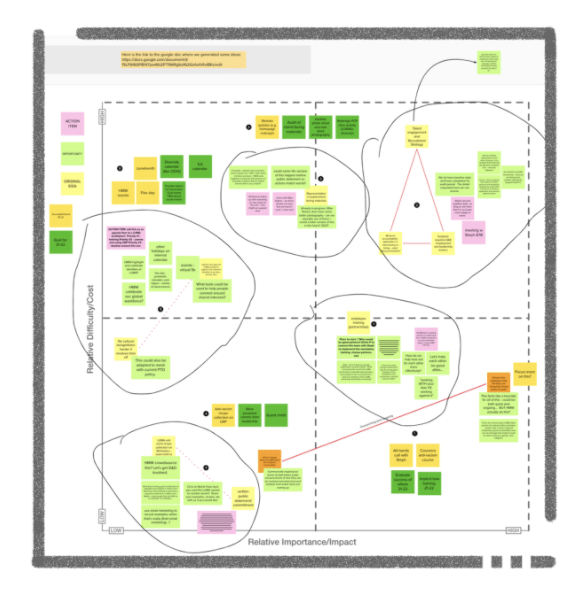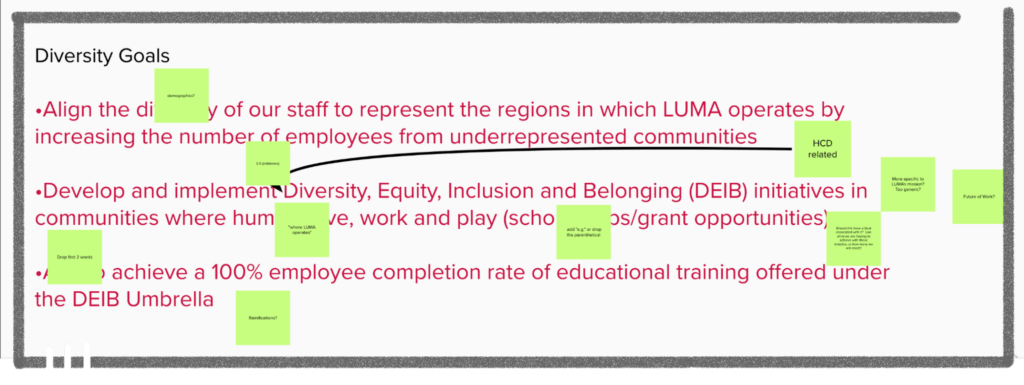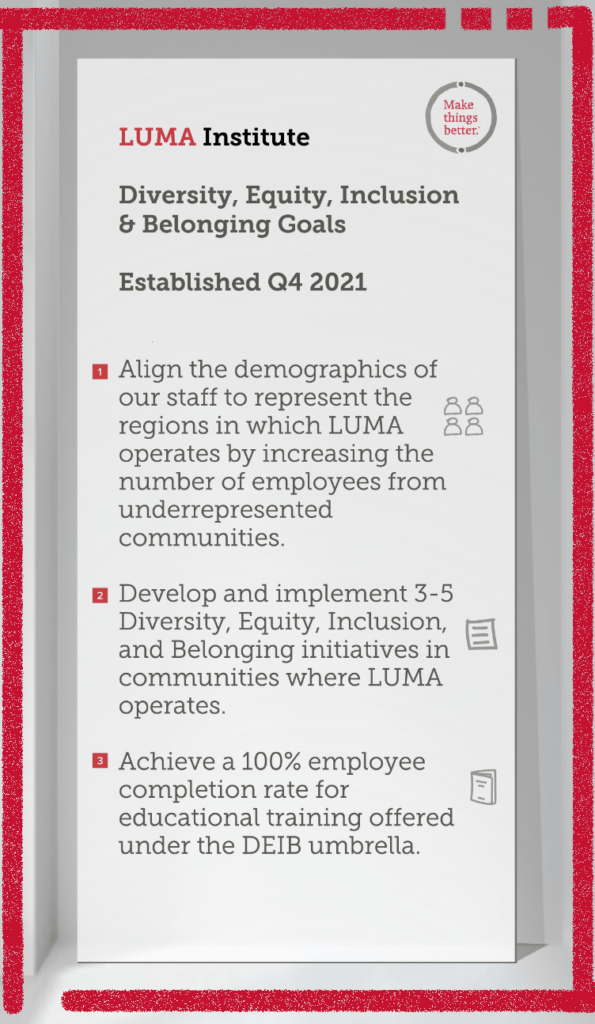Human-centered design tools, more specifically LUMA methods, were exceptionally important in helping us consider and set our DEIB (Diversity, Equity, Inclusion, and Belonging) goals. They helped us understand the needs of our employees and assisted in the development of meaningful objectives.
About 18 months ago, the LUMA Social Justice League was formed to take a deliberate look at LUMA from the inside out. We asked ourselves, “How might LUMA, knowingly or unknowingly, be contributing to the inequity that plagues our society?” We knew we needed to take actionable steps pertaining to anti-racism, diversity, and inclusiveness, but we needed to figure out how to contribute.

As conversations progressed, and ideas and opinions surfaced, it became evident that leveraging the LUMA methods would be helpful. One of the methods we used was Importance/Difficulty Matrix.
The Social Justice League plotted ideas on the matrix and made five recommendations to LUMA’s leadership team:
- Require employee training about implicit biases
- Audit and revise our hiring practices
- Improve our communications to be more inclusive
- Use the LUMA System and the power of design to combat racism
- Be more intentional about supporting and celebrating diversity internally
Action item #1: Require employee training about implicit biases
We required all employees to complete the Coursera course Anti-Racism 1, from the University of Boulder, by February 2021. This was vital in ensuring the entire team had some awareness of the history of systemic racism in the United States. Employees could complete the course at their own pace, during work hours, and were encouraged to attend pre-scheduled check-ins with the entire LUMA team throughout the course. We received overwhelmingly positive feedback about the course and the opportunity to discuss the content with teammates.
Action item #2: Audit and revise our hiring practices
LUMA hired me as its first-ever Director of People Experience and Workforce Diversity in February 2021. A big part of my role is keeping diversity, equity, and inclusion at the center of everything we do. While LUMA has always been an equal opportunity employer, it is important for us to demonstrate our appreciation for and commitment to diversity, equity, and inclusion in the forefront of our job postings. Additionally, we have been more intentional when sharing LUMA job opportunities on additional career boards and networks whose reach encompasses all ethnicities, genders, ages, abilities, neurodiversity statuses, veteran statuses, and more. These efforts – along with sharing these openings more frequently on LUMA’s social media pages – have led to a 6% increase of diverse candidates in 2021 as compared to 2020. My work in this area will continue to be a priority in 2022. Read on to learn more about that.
Action item #3: Improve our communications to be more inclusive
Our Community + Communications team has been focusing on this action item in the last year. When developing new communications materials, such as web pages and social media posts, they are mindful about incorporating people of different backgrounds and abilities. We hope that people are able to see themselves in our communications, because we believe that design is for everyone.
Action item #4: Use the LUMA System and the power of design to combat racism
In April of 2021, the Social Justice League curated a new collection of design methods focused specifically on combating racism. This collection was designed by members of the LUMA Community based on their real-life experiences working in their communities, at nonprofits, in government, and at home. Read more about this action item in a blog post from my colleague, Delaney Held and view the collection here.
Action item #5: Be more intentional about supporting and celebrating diversity internally
We’ve made real progress in the areas mentioned above, which we believe are essential to LUMA taking responsibility for our part in eradicating injustice. But we know we can do more to support diversity internally at LUMA. As an initial step, I met with stakeholders during my first few months at LUMA: employees, leadership, members of the Social Justice League, and more. I realized that there is a company-wide internal yearning for inclusion. I recommended that we create a committee to focus on all things related to company culture, and thus LUMA’s LINC was born.
LINC (Linking LUMA in New and Creative Ways) is an advisory committee dedicated to planning engaging events and working to build and strengthen relationships throughout the organization. While the committee focuses on many of our social activities, the members play a large role to ensure our culture continues to promote inclusivity. Most recently, during the LUMA Annual Summit, LINC committee members led the charge to create a year-end gift for employees that was representative of our global team. It included treats from cities around the world! It was an effort that allowed us to celebrate and learn from each other’s diverse backgrounds while creating a shared experience.
Looking forward
During a retrospective exercise in Q4 2021, the Social Justice League reviewed the original Importance/Difficulty Matrix and plotted the accomplishments for 2020 and 2021 along with the goals for 2022. Themes quickly emerged; however, it became clear that we need to do more. We need to formally establish specific goals to track how we are improving our internal culture and contributing to DEIB beyond LUMA.
Through discussions with leadership, internal stakeholders, and members of the Social Justice League, three goals were recommended. We used the Critique method to refine these goals, in this case, the green sticky notes represented opportunities to improve the proposed language.

Once the goals were finalized, they were shared with the entire organization, alongside a video narrated by Chris Pacione and myself in our internal employee newsletter. Now, we want to share them with you!

- Align the demographics of our staff to represent the regions in which LUMA operates by increasing the number of employees from underrepresented communities.
- Develop and implement 3-5 diversity, equity, inclusion, and belonging initiatives in communities where LUMA operates.
- Achieve a 100% employee completion rate for educational training offered under the DEIB umbrella.
This process is a great reminder of how using human-centered design and LUMA methods keeps you “people-focused.” As an HR strategist, I have found that it can be hugely beneficial to use design thinking as a way to consider the needs, concerns, and opinions of multiple individuals, and balance the needs of the organization to arrive at shared goals.
This process allowed me to reimagine what a true human-centered, end-to-end experience might look like when it comes to human resources. I am excited to continue collaborating and using the LUMA System so that we can achieve our DEIB goals and keep making things better together.

